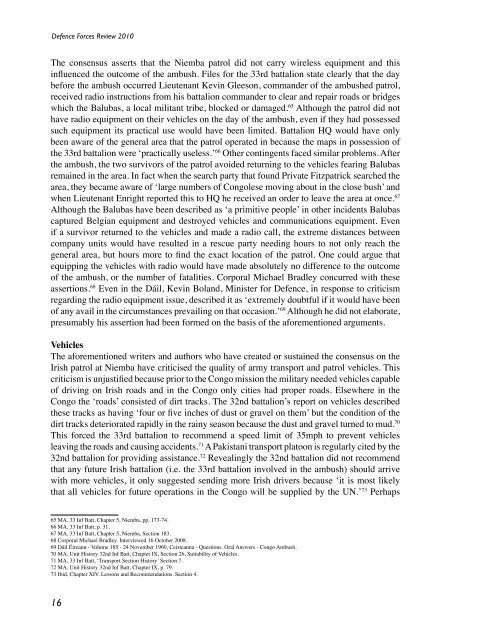Defence Forces Review 2010
Defence Forces Review 2010
Defence Forces Review 2010
Create successful ePaper yourself
Turn your PDF publications into a flip-book with our unique Google optimized e-Paper software.
<strong>Defence</strong> <strong>Forces</strong> <strong>Review</strong> <strong>2010</strong>The consensus asserts that the Niemba patrol did not carry wireless equipment and thisinfluenced the outcome of the ambush. Files for the 33rd battalion state clearly that the daybefore the ambush occurred Lieutenant Kevin Gleeson, commander of the ambushed patrol,received radio instructions from his battalion commander to clear and repair roads or bridgeswhich the Balubas, a local militant tribe, blocked or damaged. 65 Although the patrol did nothave radio equipment on their vehicles on the day of the ambush, even if they had possessedsuch equipment its practical use would have been limited. Battalion HQ would have onlybeen aware of the general area that the patrol operated in because the maps in possession ofthe 33rd battalion were ‘practically useless.’ 66 Other contingents faced similar problems. Afterthe ambush, the two survivors of the patrol avoided returning to the vehicles fearing Balubasremained in the area. In fact when the search party that found Private Fitzpatrick searched thearea, they became aware of ‘large numbers of Congolese moving about in the close bush’ andwhen Lieutenant Enright reported this to HQ he received an order to leave the area at once. 67Although the Balubas have been described as ‘a primitive people’ in other incidents Balubascaptured Belgian equipment and destroyed vehicles and communications equipment. Evenif a survivor returned to the vehicles and made a radio call, the extreme distances betweencompany units would have resulted in a rescue party needing hours to not only reach thegeneral area, but hours more to find the exact location of the patrol. One could argue thatequipping the vehicles with radio would have made absolutely no difference to the outcomeof the ambush, or the number of fatalities. Corporal Michael Bradley concurred with theseassertions. 68 Even in the Dáil, Kevin Boland, Minister for <strong>Defence</strong>, in response to criticismregarding the radio equipment issue, described it as ‘extremely doubtful if it would have beenof any avail in the circumstances prevailing on that occasion.’ 69 Although he did not elaborate,presumably his assertion had been formed on the basis of the aforementioned arguments.VehiclesThe aforementioned writers and authors who have created or sustained the consensus on theIrish patrol at Niemba have criticised the quality of army transport and patrol vehicles. Thiscriticism is unjustified because prior to the Congo mission the military needed vehicles capableof driving on Irish roads and in the Congo only cities had proper roads. Elsewhere in theCongo the ‘roads’ consisted of dirt tracks. The 32nd battalion’s report on vehicles describedthese tracks as having ‘four or five inches of dust or gravel on them’ but the condition of thedirt tracks deteriorated rapidly in the rainy season because the dust and gravel turned to mud. 70This forced the 33rd battalion to recommend a speed limit of 35mph to prevent vehiclesleaving the roads and causing accidents. 71 A Pakistani transport platoon is regularly cited by the32nd battalion for providing assistance. 72 Revealingly the 32nd battalion did not recommendthat any future Irish battalion (i.e. the 33rd battalion involved in the ambush) should arrivewith more vehicles, it only suggested sending more Irish drivers because ‘it is most likelythat all vehicles for future operations in the Congo will be supplied by the UN.’ 73 Perhaps65 MA, 33 Inf Batt, Chapter 5, Niemba, pp. 173-74.66 MA, 33 Inf Batt, p. 31.67 MA, 33 Inf Batt, Chapter 5, Niemba, Section 183.68 Corporal Michael Bradley. Interviewed 16 October 2008.69 Dáil Éireann - Volume 185 - 24 November 1960, Ceisteanna - Questions. Oral Answers - Congo Ambush.70 MA, Unit History 32nd Inf Batt, Chapter IX, Section 26, Suitability of Vehicles.71 MA, 33 Inf Batt, ‘Transport Section History’ Section 7.72 MA, Unit History 32nd Inf Batt, Chapter IX, p. 79.73 Ibid, Chapter XIV. Lessons and Recommendations. Section 4.16
















